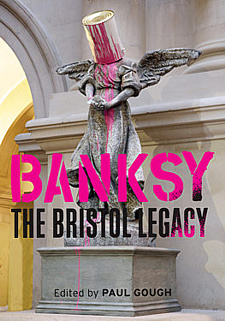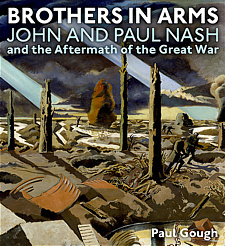H O M E • V
O R T E X 1 • V
O R T E X 2 • V
O R T E X 3 • V
O R T E X 4 • V
O R T E X 5 •
P E R S O N A
L B L O G

 |
SYMPOSIUM:
An Eye and an Ear for Conflict: War and Representation The Ways of War Centre, University of Reading 12 November 2014 Paul Gough An important part of the evolution of modern conflict is the proliferation of media through which war is comprehended. Much attention is devoted to the written word, from poetry to novels. But war has long attracted attempts to represent it through sight, sound and the moving image. Today, spectators frame clashes through viral footage, tweets and ‘live feeds’. This Symposium considers how the ‘war experience’ is mediated beyond the written word. We examine the representation of conflict through three channels of representation: pictures, language and film. Our keynote speaker, Paul Gough, will examine the art work of Paul Nash and Stanley Spencer, both of whom portrayed landscapes ‘barren, sightless, godless’. George Butler reflects on the experience of war illustrating, especially his recent work in northern Syria. Hilary Footitt explores the relationship between languages, war, and the 'foreign' in intelligence, in military–civilian relations, and in displaced communities. And Lisa Purse discusses how film represented conflict during the War on Terror. Participants from a range of disciplinary backgrounds are invited to consider how humans interpret and attempt to 'capture' conflict in visual, oral and cinematic representations. We ask what representations ‘are’ and ‘do’, across the widest possible range, as ways of imparting or denying meaning to violence, as means of creating intimacy or distance, as devices for consolation or disillusion, and as vehicles for accentuating sameness and difference. • www.reading.ac.uk/web/FILES/spirs/Invitation_An_Eye_and_an_Ear_for_Conflict.pdf • www.reading.ac.uk/spirs/research/spirs-WaysofWarCentre.aspx top |
 |
|
|
LECTURE:
The War Art of Paul Nash and Stanley Spencer The Stanley Spencer Gallery, Cookham, United Kingdom 12 November 2014 Paul Gough Paul Nash’s embittered memories of the Western Front produced some of the most searing paintings of the First World War; This lecture will explore the ‘barren, sightless, godless’ visual language of conflict by contrasting Nash’s work with that of Stanley Spencer,. After the war Spencer recreated his memory of war on the walls of the Sandham Chapel in Burghclere, a place ranked alongside the poetry of Owen and Sassoon, and Britten’s War Requiem, as amongst the ‘most moving monuments to 20th-century war.’ • www.eventbrite.co.uk/e/the-war-art-of-paul-nash-and-stanley-spencer-talk-by-prof-paul-gough-tickets-11784500759 top |
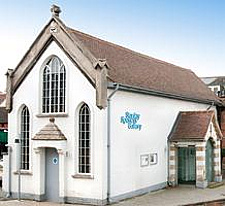 |
|
LECTURE:
Paul Nash and Stanley Spencer University of Bristol, Wills Building 11 November 2014 Paul Gough “I am no longer an artist interested and curious, I am a messenger who will bring back word from the men who are fighting to those who want the war to go on for ever. Feeble, inarticulate, will be my message, but it will have a bitter truth, and may it burn their lousy souls.” Paul Nash’s embittered memories of the Western Front produced some of the most searing paintings of the First World War. His taut renditions of the Western Front introduced a new language of devastation to the genre of landscape; his canvases have become the leitmotifs of the battlefield, rendering visual the indescribable tragedy of war. This lecture will explore the ‘barren, sightless, godless’ visual language of conflict by contrasting Nash’s work with that of Stanley Spencer, who served first in Bristol as a medical orderly, then on the forgotten front in Salonika. After the war Spencer recreated his memory of war, literally re-membering the dis-membered fragments of the fighting on the walls of the Sandham Chapel in Burghclere, a place ranked alongside the poetry of Owen and Sassoon, and Britten’s War Requiem, as amongst the ‘most moving monuments to 20th-century war.’ • www.bristol2014.com • www.facebook.com/Bristol2014 top |
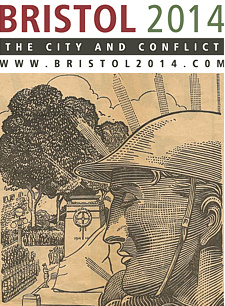 |
|
| LECTURE:
Banksy - Command, Commission and Control
CCP Centre for Contemporary Photography and Melbourne Festival, Australia Lost and Found: Ethics, subjecthood, and contemporary art 22nd October 2014 Paul Gough Paul Gough from RMIT will examine how street artists such as Banksy maintain some element of control over their public art works. Arguably the most renowned 'unknown' street artist in the world, Banksy has had to balance the free availability of his street art with protecting the exploitation of his images by others. This talk focuses on the protracted negotiations between the painter, his 'Office', the publisher and Gough in compiling a book that attempted to evaluate the artist's work. Gough examines the controls demanded
by the painter's agent, the attempts to manage the ready availability
of imagery, and the difficulties in seeking the necessary permissions
from an artist who deals almost entirely through proxies. Paul Gough is a painter, broadcaster
and writer. He has exhibited globally and is represented in the
permanent collections of the Imperial War Museum, London; Canadian
War Museum, Ottawa; and National War Memorial, New Zealand. Published
widely in cultural history, cultural geography and heritage studies,
Gough also has books on war artists, peace gardens and street artist,
Banksy. • www.ccp.org.au/lecture_series.php#lostandfound top |
||
| NEW
BOOK: Brothers in
Arms: John and Paul Nash Paul Gough with an essay by Gemma Brace (publication July 24, 2014) When brothers John and Paul Nash held their first exhibition in 1913 at the Dorien Leigh Gallery in South Kensington, London they were regarded as equally talented and equally ambitious, even though it had been Paul who had studied at the Slade School of Art amongst an extraordinary cohort of young British artists, and John was regarded as an untutored youngster with a flair for capturing the essence of the English landscape. As war broke their fortunes diverted: Paul achieved instant recognition as an Official War Artist, while John withstood the terrors of the trenches as an infantryman. In 1918 they came together again, painting side by side in an old herb barn to conjure up their searing visions of the Western Front. Once these were finished and exhibited to wide acclaim, they went their different ways. This book explores the work of the two brothers; their family roots in London and Buckinghamshire; the difficult and dark days of their schooling; their divergent early careers and time in the trenches; the moments when they came together to share a show or studio, and also the long periods where their fortune fared so differently, Paul to achieve international recognition as a Modern artist as well as a profoundly English one, while John went quietly about his southern haunts painting the countryside, studying plants and diligently engraving dozens of illustrations. Developing themes first explored in his book about British war artists, A Terrible Beauty, Paul Gough relates the fascinating story of the Nash brothers, illustrators, soldiers, and artists. Published to accompany an exhibition at the Royal West of England Academy, Bristol Brothers in Arms: John and Paul Nash 128 pages with 100 illustrations, Sansom & Company, (2014) top |
||
Brothers
in Art: John and Paul Nash Part of: Back From the Front: Art, Memory and the Aftermath of War Royal West of England Academy, Queen’s Road, Clifton, Bristol BS8 1PX 19 July – 14 September 2014 Brothers in Art: John and Paul Nash provides a unique opportunity to view the two siblings’ work side-by-side, explored within the powerful context of conflict and memory. Spanning each artist’s career, the exhibition features over forty works, including watercolours and drawings from public and private collections, creating a panoramic vision of the British countryside. Paul Nash and John Nash, both of whom served at the front and who were later commissioned as Official War Artists. The work, to be shown in the Methuen and Milner galleries of the RWA will feature the aftermath of war as the painters recovered from their experiences: The exhibition will loosely follow their (John and Paul's) divergent paths, exploring different degrees of modernism through landscape. It will focus on the English countryside whilst referring to the psychological effect of war, which seemed to strengthen the brothers' attachment to their homeland, helping create a sense of place John and Paul Nash were landscape painters in the purest sense, depicting the fields and shorelines of their native land through a particularly English sense of Modernism. They shared a unique way of looking at the land, shaped by childhood pastimes; constant and close study, and a perception of the travesty of war. By interweaving the brothers’ two very different narratives, the exhibition explores the notion of memory through the haunting beauty of the English landscape, as prehistoric sites, waterways and ancient copses build upon one another like layered memories. Nestled between Paul’s monumental hilltops and John’s swaying corn sheaves, the landscape of southern England becomes the focus; a place for remembering and forgetting. This will be the first significant exhibition of John’s work for a number of years and the first time the brothers’ work has been exhibited together on this scale. Brought together by Gemma Brace, this exhibition will be a unique showing of the artists’ post-war work and will be supported by a programme of lectures and workshops. A book by Paul Gough 'Brothers in Arms', with an essay by Gemma, will be published to coincide with the show. Image right: A Gloucestershire Landscape, John Northcote Nash, 1914, oil on canvas, WA1978.67 © Ashmolean Museum, University of Oxford © The Estate of John Nash, All Rights Reserved 2014, Bridgeman Art Library • www.rwa.org.uk top |
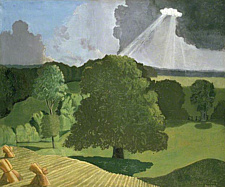 |
|
Stanley Spencer: Heaven in a Hell of War Exhibition catalogue by Paul Gough, Amanda Bradley, David Taylor, Katy Norris, Simon Martin, Jamie Hacker Hughes, Jenny Beddington. Foreword by Dame Helen Ghosh. Edited by Amanda Bradley and Howard Watson. Sir Stanley Spencer (1891-1959) stands as one of the most important English painters of the twentieth century. Best-known for his paintings which elevate ordinary village life to epic, sometimes Biblical grandeur, his most famous large-scale work is the cycle of paintings at Sandham Memorial Chapel in the village of Burghclere, Hampshire, England, now owned by the National Trust. Painted entirely from memory the canvas panels, which took six years to create, chronicle the everyday life faced by millions of soldiers during the First World War - from washing laundry to kit inspection and bed-making. As such, they offer a unique insight into the domestic and personal, rather than the combative and traumatic, experiences of the battlefield, and are considered by many to be the artist's finest achievement. This new book, produced to accompany the temporary relocation of the canvases whilst the chapel itself undergoes restoration, includes six new essays by leading experts. The essays reveal the influences behind the paintings, from Spencer's first-hand experiences of war, to Giotto's Arena Chapel murals in Padua, as well as Spencer's relationship with the family who commissioned the paintings and his contemporary Henry Lamb, and an essay giving insight into the psychological strategies Spencer used to turn his own experiences of war into these remarkable paintings. Beautifully illustrated throughout with some never-before published sketches by Spencer for the paintings and detailed explanations of each of the paintings in the cycle, this book is an essential companion to a unique war memorial created by one of Britain's best-loved painters. The paintings will be exhibited at Somerset House (London, UK) from 7 November 2013 to 26 January 2014 and at Pallant House Gallery (Chichester, West Sussex, UK) from 15 February to 15 June 2014. • http://pallant.org.uk/exhibitions1/ top |
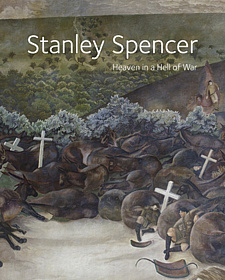 |
